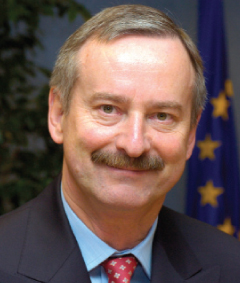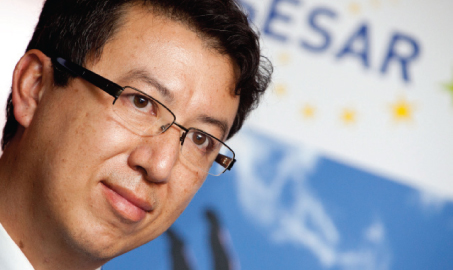
Siim Kallas, European Commission Vice-President responsible for Transport: “The construction of a true single sky has entered a crucial phase. We must put in place the concrete mechanisms that will allow the SES package to be implemented in time.”
The conference saw around 300 representatives of the EU institutions, Member States, air transport authorities and industry stakeholders discuss tangible measures to finalise implementation of the Single European Sky. By organising airspace and air navigation at a European rather than a local level, the SES initiative will increase the capacity of Europe’s skies, while also reducing aviation’s environmental impact. It is forecast that SES will result in annual savings of 500,000 tonnes of CO2, 150,000 tonnes of fuel and €200 million in fuel burn and flight time.
The four sessions focused on the new regulatory framework, a ‘gate-to-gate’ perspective of the future air traffic management system, the contribution of functional airspace blocks (FABs) to implementation of the SES, and the SES as a pan-European objective.
In February, the Single Sky Committee approved the draft Implementing Rule on Network Management, in which EUROCONTROL was nominated to become Network Manager. EUROCONTROL is now consulting with Member States in advance of taking up the role as soon as possible. Addressing the conference, David McMillan, Director General, EUROCONTROL, said: “This is an important building block towards creating a Single European Sky. It’s a vital part of the move towards a more network approach to ATM – an approach that’s essential if we are to deliver the improvements in performance that are so clearly needed. It is also a further example of the strong relationship we at EUROCONTROL are building between ourselves and the European Union. This has been a key objective of mine ever since I became Director General.”
Matthias Ruete, Director General of Mobility and Transport (DG MOVE), European Commission, expanded on this, highlighting that there are a growing number of legal instruments which formalise EUROCONTROL-EU relations. “The Commission acknowledges that this patchwork of existing instruments could be consolidated under the same umbrella so that it better reflects the true level and intensity of our cooperation in the framework of the Single European Sky. But a framework that can, by the same token, also provide a longer perspective in EU-EUROCONTROL relations,” he said.
‘Gate-to-gate’ concept
Olivier Jankovec, Director General, ACI EUROPE, participated with a presentation on the ‘gate-to-gate’ perspective and airports. He stressed that air traffic is still forecast to nearly double by 2030; while airports are currently planning for a 40% capacity increase, with five new airports and 29 new or extended runways, 10% of demand will still not be accommodated. This, explained Jankovec, will mean unprecedented congestion levels, putting SES delivery at risk. Airport capacity is the key to the success of SES2, he said. There is a need for political visibility and commitment on the issue, and a total system approach from operational concept to policy concept.
Patrick Ky, Executive Director, SESAR Joint Undertaking, concurred with Jankovec that airport capacity must be aligned with ATM capacity. He explained that for SESAR the ‘gate-to-gate’ concept means the integration of the airport into the network, including all turnaround processes. In fact, over 30% of SESAR’s work is airport related. “The key action of the SES’s technical pillar is to study a broader approach to ‘gate-to-gate’, that will close the gap between arrivals and departures, which follows-on into the complete planning of a flight from departure, cruise, arrival and again to turnaround at the other end and finally post-flight analysis,” said Ky. “In terms of concrete proposals for 2011, SESAR will bring improvements to the airlines’ operational procedures for precision area navigation aiming at increasing capacity and lowering the environmental impact in complex terminal areas. Further, airports will begin to become better integrated into the network operations, and trials for the harmonisation of arrivals and departures operations will be completed this year.”
Functional airspace blocks
The ‘Budapest Charter’ sets out the concrete and effective measures that can be taken by industry stakeholders to support implementation of the SES. It is designed to complement the SES implementation roadmap and will be used to monitor its progress. It invites airports to promote and implement collaborative decision-making, optimise the use of available capacity from airport slot allocation to ground operations, provide capacity information to the Network Manager, contribute to strategic planning and coordination through the Observatory on Airport Capacity, play an active role in the deployment of new technologies and procedures relating to the SES, and to contribute to work related to the integration of the ATM component of the forthcoming Airport Package.
The Charter requires Member States to make stringent efforts to have the functional airspace blocks completed by 4 December 2012. The establishment of FABs is regarded as a fundamental means of enabling future optimisation of the pan-European ATM system and will see Member States collectively re-design and rationalise their airspace. This will contribute to the defragmentation of airspace and should allow important economies of scale. The FABs are a key element in the creation of the SES.
Pál Völner, Hungary’s Minister of State for Infrastructure of the Ministry of National Development, said: “European air traffic control is in need of a unified, technically synchronised and cheaper system. A decision on creating the Central European Airspace Block could come as early as April.” Once that decision is made, the agreement creating the Functional Airspace Block of Central Europe (FAB CE) will be signed by the seven partner states – Austria, Bosnia-Herzegovina, the Czech Republic, Croatia, Hungary, Slovakia and Slovenia.
Bogdan Donciu, Chairman of Romatsa, the Romanian air traffic services administration, provided a brief overview of the DANUBE FAB project, comprising the airspace of Romania and Bulgaria. He emphasised that safety will be improved through redesigning airspace and harmonising ATS procedures, while the technical systems of the two ANSPs will be harmonised and will be compliant with SES regulations in terms of technical performance and interoperability.

Patrick Ky, Executive Director, SESAR Joint Undertaking: “The key action of the SES’s technical pillar is to study a broader approach to ‘gate-to-gate’, that will close the gap between arrivals and departures, which follows-on into the complete planning of a flight from departure, cruise, arrival and again to turnaround at the other end and finally post-flight analysis.”
The need for a pan-European approach to the SES is clear and there was consensus at the conference of the benefits of this approach. One of the major challenges of the SES is reducing the complexity of the European ANS system. “The deployment of pan-European functions must be thought of in such a way that it contributes to the reduction of the complexity,” said Francis Schubert, Deputy CEO, Skyguide (Swiss air navigation services).
Jules Kneepkens, Rulemaking Director, EASA, added that “It has been recognised that the involvement of European countries not Members of the European Union should be pursued, so as to ensure a proper pan-European dimension in order to facilitate the improvement of civil aviation safety throughout Europe.”
Steps towards achieving SES
Siim Kallas, European Commission Vice-President responsible for Transport, said: “The construction of a true single sky has entered a crucial phase. We must put in place the concrete mechanisms that will allow the SES package to be implemented in time. We must maintain the level of ambition that was set for us by the European institutions in establishing a long-term sustainable framework for air traffic management. This will not only give a boost to the industry; it will also make flights cheaper and reduce their impact on the environment. Our shared commitment to work quickly and constructively will determine the ultimate success of the Single European Sky.”
Three major steps towards achieving SES were announced at the conference. Firstly, a timely coordination took place between the European Commission and all partners involved in the provision of air navigation services to anticipate the impact of air traffic delays expected next summer. Short-term actions for the next six months were proposed to the conference, such as measures to enhance air traffic controllers’ mobility or to increase controlled airspace capacity. 2010 was not a good year for European Air Traffic Management. The headlines came from the volcanic ash crisis and the problems with snow – 175,000 cancellations, more than five times the figure for the previous year. EUROCONTROL’s McMillan explained that there was also a major rise in delays – from an average of 1.6 minutes to 2.7 minutes. “Now because that’s spread across all flights, it doesn’t sound much, but it is. Delays of that size cost hundreds of millions of euro. It is clearly a problem that we need to tackle, urgently,” he said. “We’re now looking ahead to the busy summer season of 2011. As is the case every year, we’ve done a lot of planning and identified problems and bottlenecks. I’m afraid to say it doesn’t look good. We’re forecasting an average delay this year of 1.8 minutes.”
The issue will be on the agenda of the Transport Council of Ministers in both March and June, for relevant follow-up actions.
Secondly, the EU and EUROCONTROL announced their intention to explore a possible high-level cooperation agreement, consolidating the reform process of EUROCONTROL as well as the essential support provided by EUROCONTROL to the implementation of SES, notably in its role as performance review body and network manager.
Thirdly, the EU and the US signed an important Memorandum of Cooperation in the field of civil aviation research and development, as well as a first annex covering cooperative activities and interoperability aspects in the framework of their respective air traffic modernisation programmes: SESAR and NextGen.
The conference concluded that enhanced cooperation between air traffic management stakeholders and extension of the SES to non-EU states can be expected to generate significant benefits.
It was also agreed that the ‘gate-to-gate’ approach – the incorporation of all phases of flights, from airport to airport, in a global approach to air traffic management – will bring major added value to SES, as will the centralisation of operational functions managed at European level and the deployment of new technologies.
In his closing address, Völner indicated that he would present the conference findings at the 31 March meeting of the Transport, Telecommunications, and Energy Council. He urged the following Polish Presidency of the EU to continue to support implementation of the Single European Sky programme.







